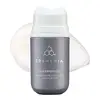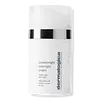What's inside
What's inside
 Key Ingredients
Key Ingredients

 Benefits
Benefits

 Concerns
Concerns

 Ingredients Side-by-side
Ingredients Side-by-side

Water
Skin ConditioningCaprylic/Capric Triglyceride
MaskingGlycerin
HumectantPentylene Glycol
Skin ConditioningGlyceryl Stearate
EmollientLactobacillus Ferment Lysate Filtrate
Skin ConditioningHydrogenated Ethylhexyl Olivate
EmollientSqualane
EmollientMangifera Indica Seed Butter
Skin ConditioningVitis Vinifera Fruit Extract
Skin ConditioningZingiber Officinale Root Extract
MaskingBoswellia Serrata Extract
Skin ConditioningChlorella Vulgaris Extract
Skin ConditioningRhodiola Rosea Root Extract
EmollientInonotus Obliquus Extract
Skin ConditioningGanoderma Lucidum Extract
Skin ProtectingWithania Somnifera Root Extract
Skin ConditioningLeuconostoc/Radish Root Ferment Filtrate
AntimicrobialPopulus Tremuloides Bark Extract
AntiseborrhoeicTremella Fuciformis Sporocarp Extract
AntioxidantPanthenol
Skin ConditioningBisabolol
MaskingCetearyl Alcohol
EmollientXanthan Gum
EmulsifyingHydroxyacetophenone
AntioxidantAmmonium Acryloyldimethyltaurate/Vp Copolymer
Sodium Stearoyl Lactylate
Emulsifying1,2-Hexanediol
Skin ConditioningCaprylyl Glycol
EmollientSodium Hydroxide
BufferingHydrogenated Olive Oil Unsaponifiables
EmollientPropanediol
SolventLavandula Angustifolia Flower/Leaf/Stem Extract
MaskingSodium Phytate
Citric Acid
BufferingLactic Acid
BufferingSodium Benzoate
MaskingWater, Caprylic/Capric Triglyceride, Glycerin, Pentylene Glycol, Glyceryl Stearate, Lactobacillus Ferment Lysate Filtrate, Hydrogenated Ethylhexyl Olivate, Squalane, Mangifera Indica Seed Butter, Vitis Vinifera Fruit Extract, Zingiber Officinale Root Extract, Boswellia Serrata Extract, Chlorella Vulgaris Extract, Rhodiola Rosea Root Extract, Inonotus Obliquus Extract, Ganoderma Lucidum Extract, Withania Somnifera Root Extract, Leuconostoc/Radish Root Ferment Filtrate, Populus Tremuloides Bark Extract, Tremella Fuciformis Sporocarp Extract, Panthenol, Bisabolol, Cetearyl Alcohol, Xanthan Gum, Hydroxyacetophenone, Ammonium Acryloyldimethyltaurate/Vp Copolymer, Sodium Stearoyl Lactylate, 1,2-Hexanediol, Caprylyl Glycol, Sodium Hydroxide, Hydrogenated Olive Oil Unsaponifiables, Propanediol, Lavandula Angustifolia Flower/Leaf/Stem Extract, Sodium Phytate, Citric Acid, Lactic Acid, Sodium Benzoate
Water
Skin ConditioningDimethicone
EmollientMethylheptyl Isostearate
Skin ConditioningButylene Glycol
HumectantNiacinamide
Smoothing1,2-Hexanediol
Skin ConditioningCetearyl Ethylhexanoate
EmollientCetyl Alcohol
EmollientIsohexadecane
EmollientCetearyl Alcohol
EmollientGlyceryl Stearate Citrate
EmollientRubus Idaeus Seed Oil
EmollientVaccinium Macrocarpon Seed Oil
Skin ConditioningHexylresorcinol
AntimicrobialLactobacillus/Pumpkin Ferment Extract
Skin ConditioningCananga Odorata Flower Oil
MaskingCitrus Aurantium Dulcis Peel Oil
MaskingCitrus Limon Peel Oil
MaskingPrunus Amygdalus Dulcis Oil
Skin ConditioningJuniperus Mexicana Oil
MaskingRosa Damascena Flower Oil
MaskingHydroxyacetophenone
AntioxidantDipotassium Glycyrrhizate
HumectantLactobacillus Ferment
Skin ConditioningPotassium Cetyl Phosphate
EmulsifyingHydrogenated Phosphatidylcholine
EmulsifyingPhytosterols
Skin ConditioningDimethicone Crosspolymer
Emulsion StabilisingAcrylates/C10-30 Alkyl Acrylate Crosspolymer
Emulsion StabilisingAminomethyl Propanol
BufferingGlyceryl Caprylate
EmollientPolysilicone-11
Tocopherol
AntioxidantTetrasodium Glutamate Diacetate
Zinc Glycinate
BufferingMagnesium Ascorbyl Phosphate
AntioxidantIsostearic Acid
CleansingBenzyl Benzoate
AntimicrobialDecyl Glucoside
CleansingBenzyl Salicylate
PerfumingSodium Hydroxide
BufferingSodium Glycolate
BufferingSodium Formate
BufferingDimethiconol
EmollientLimonene
PerfumingFarnesol
PerfumingWater, Dimethicone, Methylheptyl Isostearate, Butylene Glycol, Niacinamide, 1,2-Hexanediol, Cetearyl Ethylhexanoate, Cetyl Alcohol, Isohexadecane, Cetearyl Alcohol, Glyceryl Stearate Citrate, Rubus Idaeus Seed Oil, Vaccinium Macrocarpon Seed Oil, Hexylresorcinol, Lactobacillus/Pumpkin Ferment Extract, Cananga Odorata Flower Oil, Citrus Aurantium Dulcis Peel Oil, Citrus Limon Peel Oil, Prunus Amygdalus Dulcis Oil, Juniperus Mexicana Oil, Rosa Damascena Flower Oil, Hydroxyacetophenone, Dipotassium Glycyrrhizate, Lactobacillus Ferment, Potassium Cetyl Phosphate, Hydrogenated Phosphatidylcholine, Phytosterols, Dimethicone Crosspolymer, Acrylates/C10-30 Alkyl Acrylate Crosspolymer, Aminomethyl Propanol, Glyceryl Caprylate, Polysilicone-11, Tocopherol, Tetrasodium Glutamate Diacetate, Zinc Glycinate, Magnesium Ascorbyl Phosphate, Isostearic Acid, Benzyl Benzoate, Decyl Glucoside, Benzyl Salicylate, Sodium Hydroxide, Sodium Glycolate, Sodium Formate, Dimethiconol, Limonene, Farnesol
Alternatives
Ingredients Explained
These ingredients are found in both products.
Ingredients higher up in an ingredient list are typically present in a larger amount.
1,2-Hexanediol is a synthetic liquid and another multi-functional powerhouse.
It is a:
- Humectant, drawing moisture into the skin
- Emollient, helping to soften skin
- Solvent, dispersing and stabilizing formulas
- Preservative booster, enhancing the antimicrobial activity of other preservatives
Cetearyl alcohol is a mixture of two fatty alcohols: cetyl alcohol and stearyl alcohol. It is mainly used as an emulsifier. Emulsifiers help prevent the separation of oils and products. Due to its composition, it can also be used to thicken a product or help create foam.
Cetearyl alcohol is an emollient. Emollients help soothe and hydrate the skin by trapping moisture.
Studies show Cetearyl alcohol is non-toxic and non-irritating. The FDA allows products labeled "alcohol-free" to have fatty alcohols.
This ingredient is usually derived from plant oils such as palm, vegetable, or coconut oils. There is debate on whether this ingredient will cause acne.
Due to the fatty acid base, this ingredient may not be Malassezia folliculitis safe.
Learn more about Cetearyl AlcoholHydroxyacetophenone is antioxidant with skin conditioning and soothing properties. It also boosts the efficiency of preservatives.
This ingredient is not irritating or sensitizing.
Sodium Hydroxide is also known as lye or caustic soda. It is used to adjust the pH of products; many ingredients require a specific pH to be effective.
In small amounts, sodium hydroxide is considered safe to use. However, large amounts may cause chemical burns due to its high alkaline.
Your skin has a natural pH and acid mantle. This acid mantle helps prevent harmful bacteria from breaking through. The acid mantle also helps keep your skin hydrated.
"Alkaline" refers to a high pH level. A low pH level would be considered acidic.
Learn more about Sodium HydroxideWater. It's the most common cosmetic ingredient of all. You'll usually see it at the top of ingredient lists, meaning that it makes up the largest part of the product.
So why is it so popular? Water most often acts as a solvent - this means that it helps dissolve other ingredients into the formulation.
You'll also recognize water as that liquid we all need to stay alive. If you see this, drink a glass of water. Stay hydrated!
Learn more about Water